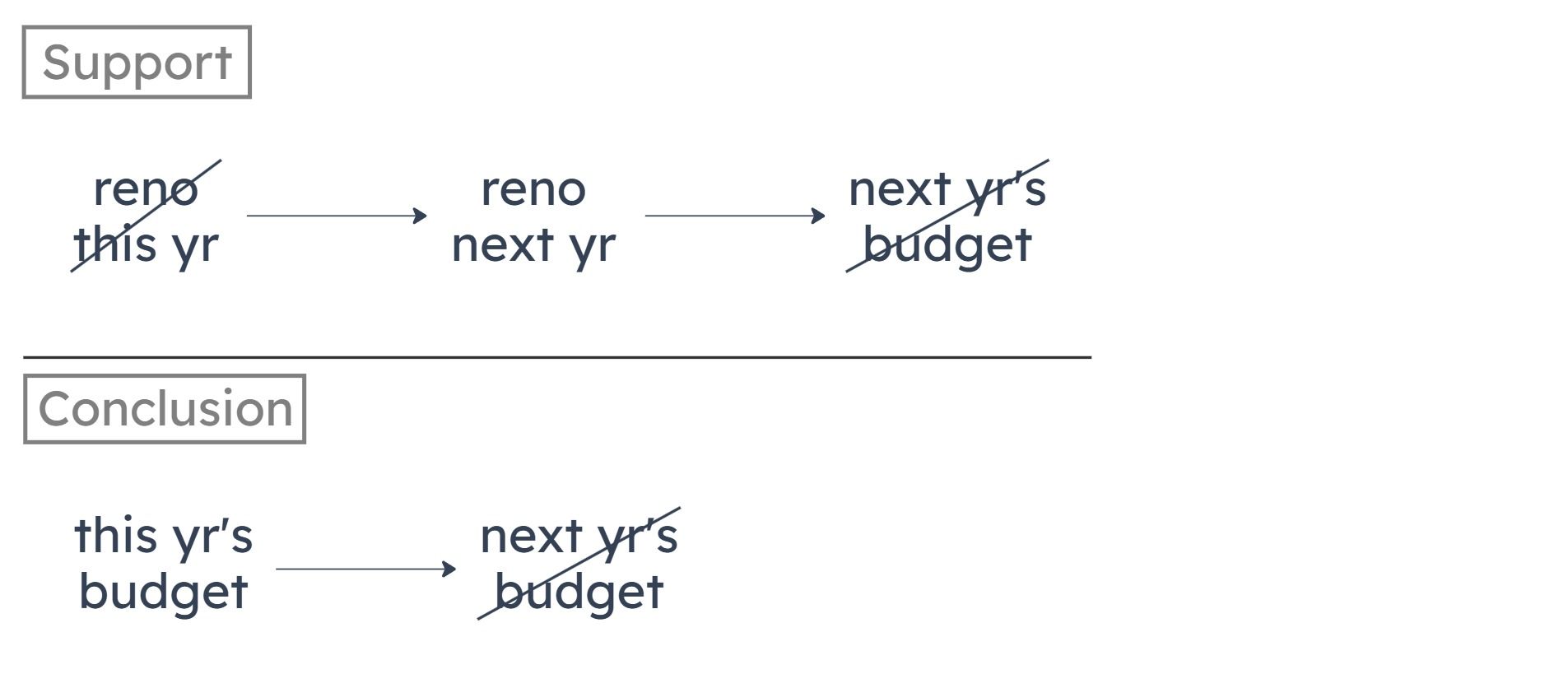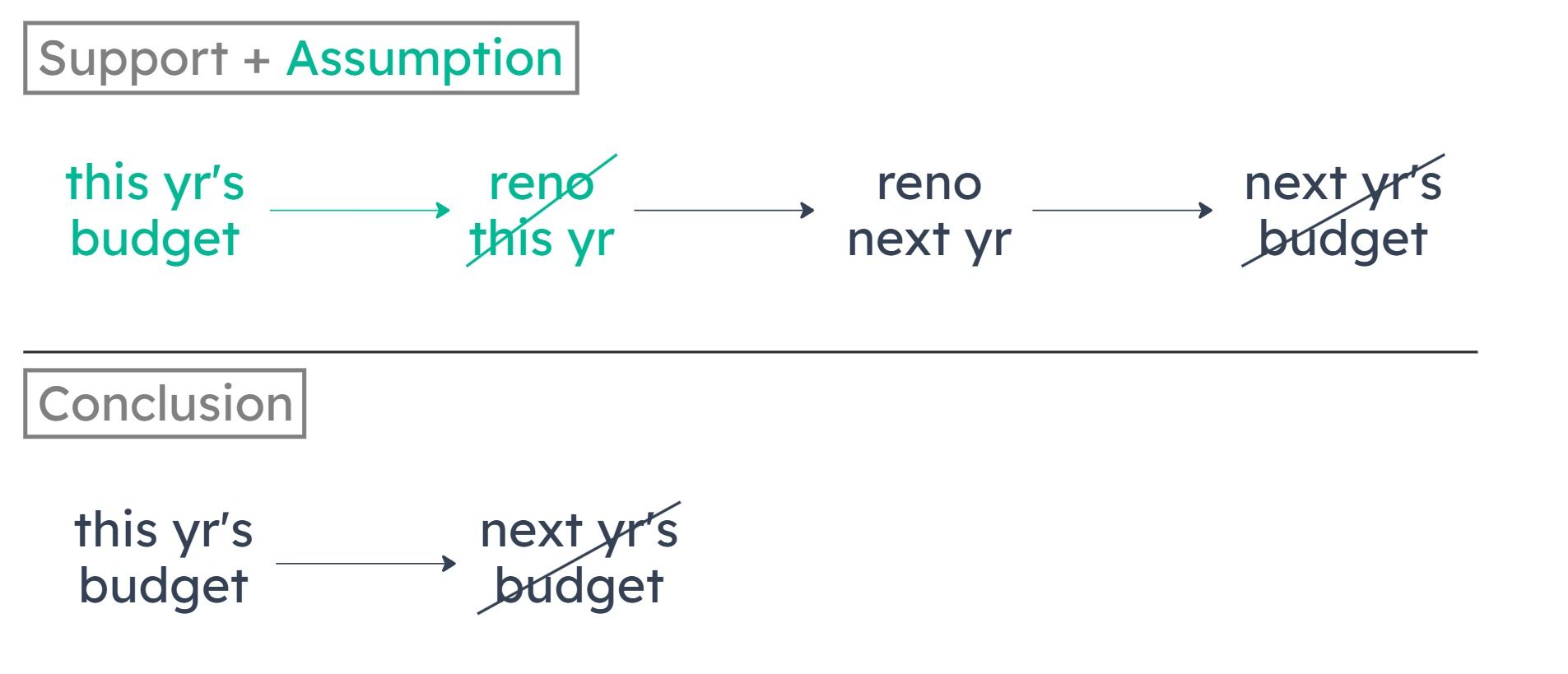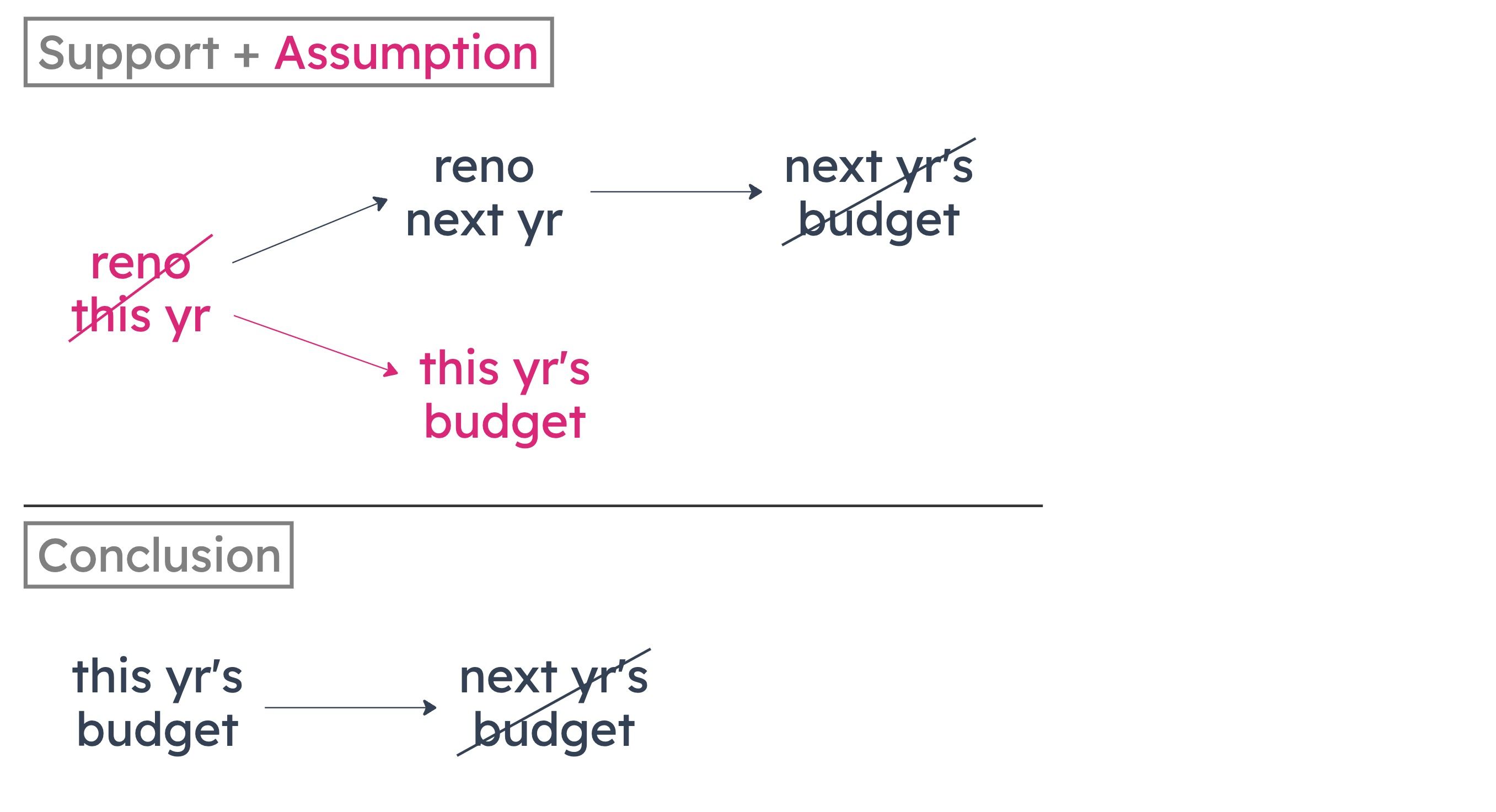(1) If the museum doesn’t renovate this year, it must renovate next year.
(2) If the museum renovates next year, it won’t stay within next year’s budget.

Specifically, we can reach the author’s conclusion if we assume that to stay within this year’s budget, the museum must not renovate this year. (Contrapositive: If the museum renovates this year, it must not stay within this year’s budget.)
A
The museum will stay within this year’s budget.
B
This year’s budget is less than next year’s budget.
C
The museum will not renovate next year.
D
The museum will exceed this year’s budget if it renovates this year.

E
The museum will stay within this year’s budget if it does not renovate this year.

Rodent populations increase during long periods of sustained rain
El Nono, which causes heavy rainfall in region T, is expected to become much more frequent due to global warming
The Ecologist also assumes that there are no unintended consequences from sustained levels of heavy rainfall that would offset the increases to the rodent population.
A
In region T, there is typically much less rainfall in summer than there is in winter.
B
Rodent populations in region T often diminish during long periods in which there are no heavy rains.
C
In many regions that, on average, experience substantially more winter rainfall than region T does, average rodent populations are considerably lower than they are in region T.
D
In region T, winters marked by relatively high rainfall have usually not been marked by long periods of sustained rain.
E
The global warming caused by air pollution produces a number of effects, other than the increase in the frequency of El Niño, that could affect rodent populations.
Journalists often claim that their investigation of the private lives of political leaders is an effort to improve society by forcing the powerful to conform to the same standards of conduct as the less powerful. In reality, however, the tactic is detrimental to society. It makes public figures more concerned with mere appearances, and makes everyone else cynical about the character of their leaders.
Summarize Argument: Counter-Position
While journalists argue that their investigations of the private lives of political leaders improves society, it is actually detrimental to society. This is because it makes public figures more concerned with appearances and makes everyone else cynical about their leaders.
Identify Argument Part
The argument part refers to the position that journalists often claim. The author then says that position has bad consequences.
A
It is a claim that the argument attempts to refute.
This is incorrect because the author is not refuting that journalists view their investigations as an effort to hold the powerful to the same standards as less powerful citizens. The author is merely saying that effort has negative consequences.
B
It mentions a justification that is sometimes offered for a practice that, the argument concludes, has undesirable consequences.
This is correct because the argument part mentions the journalists’ justification for their practice of investigating the private lives of politicians. The author then concludes this investigating has negative consequences.
C
It is cited as evidence often given for an assertion that the argument concludes is false.
This is incorrect because the author isn’t concluding that journalists are wrong to assert that their investigations are an effort to hold the powerful and less powerful to the same standards. The author is merely arguing that practice has other, bad consequences.
D
It describes a phenomenon that, according to the argument, is much less damaging to society than journalists often assume.
This is incorrect because the author actually argues that the phenomenon is more damaging than what journalists assume.
E
It gives an example of a phenomenon that the argument contends has very different effects from those it is generally assumed by everyone to have.
This is incorrect because we don’t know whether or not it is generally assumed by everyone that journalists’ investigations into the private lives of politicians will have the positive effects journalists claim.
A
It is a premise used as support for the overall conclusion of the anthropologist’s argument.
B
It is a clarification of one of the premises of the anthropologist’s argument.
C
It is an objection that the anthropologist raises against an opposing theory.
D
It is the overall conclusion of the anthropologist’s argument.
E
It describes a claim that the anthropologist attempts to refute.
Peterson: Ionic liquids cost many times as much as organic solvents, so they are currently not practical for the chemical industry.
A
The cost of organic solvents is only one of many expenses involved in industrial production of chemicals.
B
New methods for removing by-products of chemical reactions have recently been developed.
C
The chemical industry has historically been quick to adopt new techniques that increase the rate at which reactions occur.
D
Ionic liquids can be reused many times, whereas organic solvents can be used only once.
E
For the sake of public relations, companies will sometimes use a more environmentally friendly process even if it is slightly more expensive.
Because according to Newtonian theory, gravitational force between two bodies depends exclusively on mass/distance, and does not depend on what the bodies are made of.
To go further, we can try to anticipate a more specific connection between the premise and the conclusion. The premise establishes that to calculate gravitational force, we don’t need to consider “what the bodies are made of.” That part supports the idea that, in order to calculate graviational force, we don’t need to consider the structure/constitution of a body (because structure/constitution concerns what bodies are made of).
But what if calculating the orbits of bodies involves more than just calculating gravitational force between them? That opens the possibility that structure/constitution could be important for other factors that are relevant to calculating orbits. We want to eliminate this possibility. We want to establish that in order to calculate orbits, we don’t need anything else besides calculating gravitational force.
A
Mass is dependent on gravitational force.
B
According to the Newtonian theory, the calculation of planetary orbits requires considering only their gravitational forces.
C
The Newtonian theory of gravity is mistaken about the data needed to calculate gravitational force.
D
Knowing what an object is made of is sufficient for determining its mass.
E
The gravitational force between the Sun and a planet is a factor in determining the distance between them.
The Researcher also assumes that the animal studies used to introduce a premise are applicable to humans.